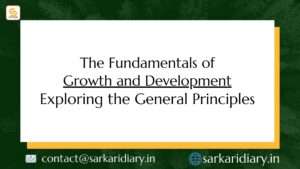Fundamentals of Growth & Development: Growth and development are essential processes that shape every living organism. While closely connected, the concepts have distinct meanings:
Growth: Quantitative changes in an organism’s physical characteristics like height, weight, and body composition.
Development: Qualitative changes involving the progression of skills and abilities across various domains, including cognitive, emotional, social, and physical development.
Understanding the fundamentals of growth and development offers insights into our physical bodies, how we learn and think, our relationships with others, and our overall well-being.

Principles of Growth and Development
Several key principles guide the processes of growth and development:
Continuous and Gradual: Growth and development don’t happen in sudden leaps but are ongoing processes occurring throughout the lifespan.
Sequential: Stages of development typically follow a predictable order. For example, babies learn to roll over before sitting up and sitting up before walking.
Individual Differences: While there are general patterns, everyone grows and develops at their own pace, influenced by genetics and environmental factors.
Holistic: Growth and development encompass various interconnected areas—physical, cognitive, social, and emotional. Progress in one area can influence others.
Influence of Nature and Nurture: Both genetics (“nature”) and environmental factors (“nurture”) play crucial roles in shaping growth and development.
Patterns of Growth
Certain patterns characterize physical growth:
Cephalocaudal pattern: Growth proceeds from head to toe. Infants gain control over their head and neck before acquiring the skills to sit, stand, and walk.
Proximodistal pattern: Growth progresses from the center of the body outward. Babies learn to use their arms before developing fine motor control of their hands and fingers.
Factors Influencing Growth and Development
Numerous factors interact to shape an individual’s growth and developmental trajectory:
Genetics: Hereditary factors provide a blueprint for growth and development, determining traits like potential height, build, and predisposition to certain health conditions.
Nutrition: Adequate nutrition is essential for healthy growth. Malnutrition can lead to stunted growth and developmental delays.
Hormones: Hormones like growth hormone and thyroid hormone significantly impact physical growth and development.
Environment: Factors such as a safe and stimulating home environment, access to quality education, and exposure to positive social interactions promote healthy development.
Health: Chronic illness or disease can hinder growth and development.
Culture: Cultural values, beliefs, and practices shape a child’s understanding of the world, affecting their social and emotional development.
Stages of Development
Human development is commonly divided into the following stages:
Prenatal Development: The period from conception to birth, involving rapid growth and cell differentiation.
Infancy (0-2 years): A period of tremendous growth and development. Infants acquire basic motor skills, learn to communicate, and develop attachment to caregivers.
Early Childhood (3-5 years): Characterized by advances in language, cognitive abilities, and social-emotional skills. Children become more independent and engage in imaginative play.
Middle Childhood (6-11 years): Academic skills become a focus, along with peer relationships and a developing sense of self.
Adolescence (12-18 years): A period marked by puberty, significant physical changes, and the search for identity. Relationships with peers become increasingly important.
Early Adulthood (19-40 years): Individuals typically establish themselves in their careers, form intimate relationships, and start families.
Middle Adulthood (40-65 years): A time of potential physical changes, career stability, and evolving family relationships.
Late Adulthood (65+ years): Physical changes become more apparent. People reflect on their lives and may experience transitions like retirement or the loss of loved ones.
Key Areas of Development
Let’s explore some of the core areas of development:
Physical Development: Includes gross motor skills (large body movements like walking and running), fine motor skills (use of hands and fingers), and changes in body proportions and composition.
Cognitive Development: Encompasses thinking, problem-solving, language development, memory, attention, and perception.